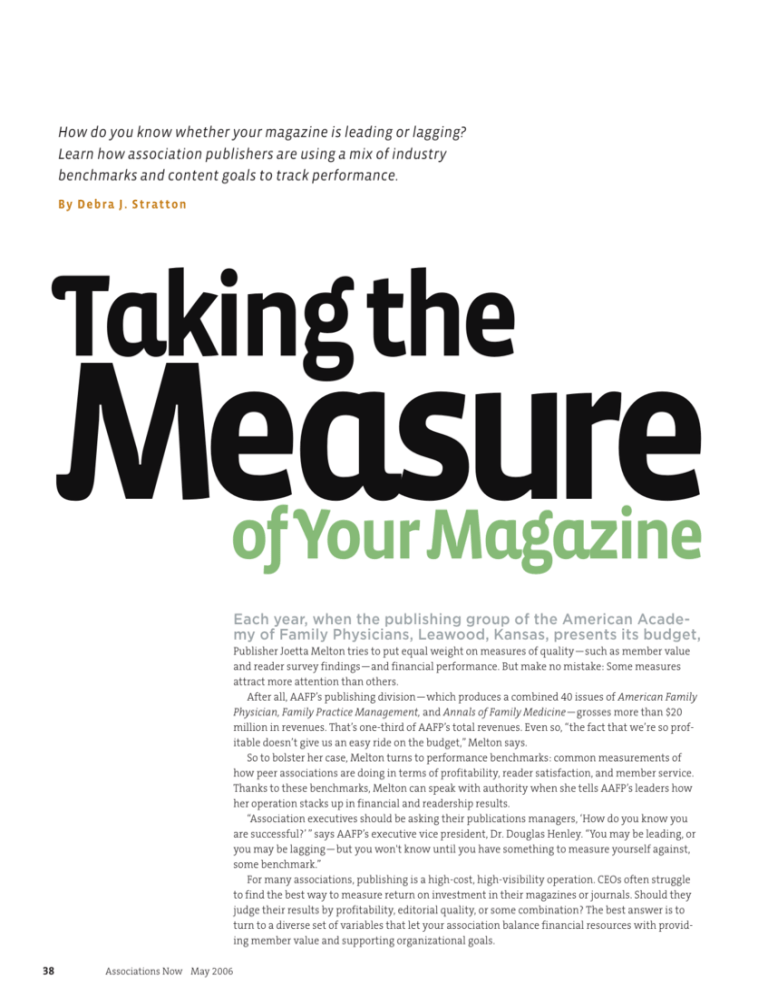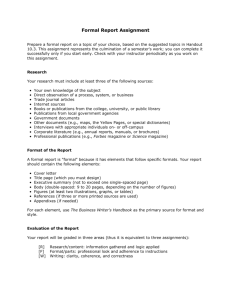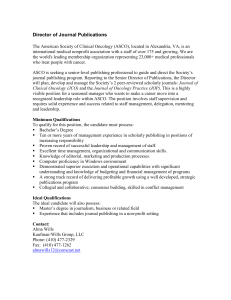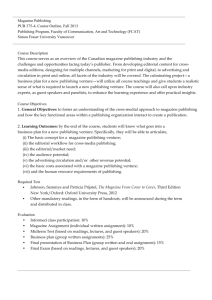Taking the Measure of Your Magazine
advertisement

How do you know whether your magazine is leading or lagging? Learn how association publishers are using a mix of industry benchmarks and content goals to track performance. B y D e b ra J . S t ra t t o n Taking the Measure of Your Magazine Each year, when the publishing group of the American Academy of Family Physicians, Leawood, Kansas, presents its budget, Publisher Joetta Melton tries to put equal weight on measures of quality—such as member value and reader survey findings—and financial performance. But make no mistake: Some measures attract more attention than others. After all, AAFP’s publishing division—which produces a combined 40 issues of American Family Physician, Family Practice Management, and Annals of Family Medicine—grosses more than $20 million in revenues. That’s one-third of AAFP’s total revenues. Even so, “the fact that we’re so profitable doesn’t give us an easy ride on the budget,” Melton says. So to bolster her case, Melton turns to performance benchmarks: common measurements of how peer associations are doing in terms of profitability, reader satisfaction, and member service. Thanks to these benchmarks, Melton can speak with authority when she tells AAFP’s leaders how her operation stacks up in financial and readership results. “Association executives should be asking their publications managers, ‘How do you know you are successful?’ ” says AAFP’s executive vice president, Dr. Douglas Henley. “You may be leading, or you may be lagging—but you won't know until you have something to measure yourself against, some benchmark.” For many associations, publishing is a high-cost, high-visibility operation. CEOs often struggle to find the best way to measure return on investment in their magazines or journals. Should they judge their results by profitability, editorial quality, or some combination? The best answer is to turn to a diverse set of variables that let your association balance financial resources with providing member value and supporting organizational goals. 38 Associations Now May 2006 Why Performance Tracking Matters When Steve Comstock wants to assess his association’s flagship magazine, he goes straight to the bottom line and compares performance against financial goals and benchmarks. But he also looks at editorial content to ensure that the magazine “appeals to a broad membership base and demonstrates the value of membership to potential members,” says Comstock, director of communications and education at the Atlanta-based American Society of Heating, Refrigerating, and Air-Conditioning Engineers, which publishes ASHRAE Today. Bottom-line performance is the critical factor as well for the American School Board Journal, according to Publisher and Assistant Executive Director Marilee Rist of the National School Boards Association, Alexandria, Virginia. “American School Board Journal is unusual in the association world in that it is editorially independent of its owner, the National School Boards Association,” explains Rist. The magazine is sold entirely by subscription and not provided as part of member dues. “It’s expected to generate enough subscription and advertising revenues to support itself and return net revenue to the association,” she says. “So our basic performance measure is pretty simple: Generate net revenue. In today's publishing world, that's a huge and growing challenge.” The Society of American Florists, Alexandria, Virginia, uses associationpublishing benchmarks to “see the profile of publications that do make a profit,” says Kate Penn, vice president for publications and communications and editor in chief. Floral Management, with gross revenues of nearly $400,000, is not yet profitable, but Penn uses industry benchmarks to help her board understand the appropriate measurements. She points to new data from the Association Publishing Benchmarking Study, released in mid-2005 by the Angerosa Research Foundation in 40 Associations Now May 2006 partnership with Stratton Publishing & Marketing (both in Alexandria, Virginia) and the Society of National Association Publications, McLean, Virginia, as an important tool for assessing her magazine. “It enables us to answer the natural questions from a new board of directors about return on investment and profitability factors.” How does the study help? The full report tracks publishing expenses— production costs, design, editorial, advertising sales, circulation, and total expenses—as a percentage of revenue. Then the report breaks these expenses down among publications of similar size and scope by revenues, frequency, circulation, and issue size. It also offers staffing metrics by publication size and trends and practices among print and Web operations. The result is true comparisons of efficiency and profitability among peer publications. Beyond Financial Returns As associations continue to leverage publications to advance their organizational missions and boost member value, they find it especially important to measure ROI accurately. About half of the publications that participated in the 2005 Association Publishing Benchmarking Study generate a profit after direct expenses and salaries. However, not all publishing operations have profitability as a goal. Many organizations measure return on investment both in terms of delivering value and serving as highly visible reminders of why members belong to the association in the first place. That’s been the focus for the last year at the Assisted Living Federation of America, Alexandria, Virginia. As part of a strategic realignment, the association doubled its editorial-development budget to ensure that its content appealed to ALFA’s new target of so-called “C-level” executives (e.g., CEOs, COOs, CFOs, and so forth). “We knew we’d take a short-term hit on the bottom line,” says Richard P. Grimes, ALFA’s president and CEO. “But in our efforts to be recognized in the industry for continuously raising the bar in operational excellence, we thought the investment was worth it in the long haul. We’re certain we’ll see the payoff in membership dues and increased appeal in the advertising market.” Grimes tracks the success of the publishing operations in monthly strategy meetings with his publications manager and through quarterly written reports that include financial performance compared to current and previous-year budgets, previews of upcoming content based on topics previously identified in phone conversations with C-level executives, and other key criteria. He also hears anecdotal evidence from members and suppliers about improved editorial quality. Measuring Against the Benchmarks Regardless of whether your publication seeks to generate a profit, how do you know whether performance is better or worse than other association-publishing operations? CEOs can use a variety of benchmarks to evaluate performance, such as comparing market share against competitors, evaluating readership feedback and usefulness indicators, or comparing circulation statistics. For financial-operation comparisons, commercial publications often turn to ratio reports generated by American Business Media. Associations can use the Association Publishing Benchmarking Study, which tracks data for 114 advertising-supported national magazines and journals. The data on expense-to-revenue operating ratios offer comparisons and metrics that associations can use to assess performance and also verify industry standards with top management and elected leaders. It’s one thing to tell them you think your publication fares better than other association publications; it’s quite another to show them. The study’s findings indicate that the business of association publishing is healthy. Consider the following: n About half of the publications report n n net profits after direct expenses and salary allocations. That’s a major increase from the first association benchmarking study in 1998, when only 39 percent of respondents reported being profitable. The median profit for all publications (after salaries and direct expenses) is $420,139, based on 2004 data. Association publications operate lean, spending just 15 to 20 percent of revenues on editorial and 10 to 15 percent on design, for example. Making Adjustments for Operating Efficiency In each benchmarking category, publishers may find opportunities to streamline operations, increase productivity, or make investments that, in one way or another, boost ROI. For instance, 10 years ago at AAFP, the publishing division employed a production staff of six who were responsible for producing 26 issues annually. Today, the same staff of six produces annually 40 issues combined of three publications, boosting the department’s productivity by more than 50 percent. It’s a striking example of how to run publishing operations as a business, says Melton. “We’re always striving to be lean and mean. We made the required investments in technology that allowed these people to be increasingly efficient, which has turned out to be a good business decision.” AAFP found further evidence of just how lean its operation is. Its flagship publication generates the highest revenues reported in the benchmarking study—$20 million. But the flagship publication has only 27.4 full-timeequivalent employees, compared to the study high of 45 FTEs. Beyond Profitability Lean operations don’t develop overnight. At the Electronic Transaction Association, Washington, DC, Transaction Trends is “closing the gap” to profitability and improving the bottom line each year, says Executive S I X S T R AT E G I E S T O I M P R O V E Y O U R R O I A Q U I C K G U I D E F O R C E O S W H O WA N T T O P U B L I S H WITHOUT PERISHING 1. Once you hire smart publications managers, give them the financial tools they need and let them do their jobs. One of the biggest challenges identified in the Association Publishing Benchmarking Study: Publication managers have trouble obtaining complete, accurate data on a publication’s expenses and operating costs. Often, key expenses for such items as printing, postage, or shared-staffing costs are not tracked by publication. This makes it difficult, if not impossible, to fully assess all the costs associated with publishing. 2. Set up a schedule for monthly or quarterly updates of key performance metrics. At the Society for Human Resource Management, Chief Publications Officer Gary Rubin provides his CEO with quarterly reports showing trailing and leading 12-month indicators. He also reports on market challenges (and what he’s doing to overcome them) and areas for new opportunities. At the American Academy of Family Physicians, Publisher Joetta Melton plugs financial statistics into a spreadsheet and continually projects results through the end of the year. Month by month, the leadership knows how publishing operations are tracking for year-end so there are no surprises. 3. Ensure that your publications managers are tracking benchmarks to compare efficiency. Managers need to use available tools to compare expenses, measure market share, evaluate performance against prior years, and compare practices and operations against industry benchmarks. Benchmarks provide more than just financial comparisons. They can also guide association publishers to improved performance and strategies for streamlining operations. 4. Set a business plan for your publications and measure performance against it. In addition to encouraging investments that generate longer-range returns, a plan can also help you avoid knee-jerk cuts for short-term financial improvements. “We believe our structure is built for the long haul,” says Ken Koepper, publisher of Industrial Launderer, the flagship publication of the Uniform & Textile Service Association, Arlington, Virginia. UTSA has a unique program in which a certain level of advertising commitment is built into membership for supplier members. This gives the magazine an initial level of support on which it can build. So you can keep the long view, Koepper recommends being mindful of the ups and downs of the advertising market and of market upheavals that can affect readership. 5. Invest in research to support the publication’s value quotient. “We use research— readership, advertiser feedback, market research, and so forth—as essential tools to help us implement effective publishing practices and ensure we are heading in the right direction,” says Steve Comstock, director of communications and education at the American Society of Heating, Refrigerating, and Air-Conditioning Engineers. “We report that direction, measure our performance fiscally, examine the product as a membership benefit, and try to educate volunteer leadership about what we’re doing and why.” 6. Be willing to take risks. That may be easier in some organizations than others. But start by gathering market intelligence, immersing yourself in financial benchmarks and projections, and investing in the content you need to build highly effective, diverse, and profitable publishing operations. Then test new products and build on success. “You have to continually have a series of new projects coming down the pipeline—some with high margins and others without—but with a blended ROI that provides a net return,” says Rubin, who is soon to unveil a major new media initiative. Associations Now May 2006 41 Director Carla Balakgie, CAE. The bimonthly magazine, which circulates to 2,000 professionals in 550 member companies, generates about $350,000 in annual advertising revenues. Because nondues revenues help subsidize other activities for the $3.7 million organization, the publication is pressured to generate revenues, but it has not yet achieved profitability. “While profitability is an ultimate goal, our board is equally concerned that we operate effectively and produce an excellent product that delivers value— sort of the ‘balanced scorecard’ approach,” explains Balakgie. To better assess the magazine’s true ROI potential and understand the competitive market in which the magazine operates, Balakgie commissioned a competitive market analysis of Transaction Trends about two years ago. The study revealed that CO M M O N C H A RAC T E R I ST I C S O F P R O F I TA B L E P U B L I C AT I O N S If you’re looking for ways to boost your magazine’s financial performance, consider the following factors that profitable publications had in common in the Association Publishing Benchmarking Study. n Frequency: Profitable magazines are published at least monthly, giving them a favorable environment for advertisers. n Size: They have an average per-issue size of 88 pages. n Advertising/editorial ratio: They adhere to a tighter adto-edit ratio than most publications, which reflects the importance of using advertising page counts to determine each issue’s overall page count and ensure that ad revenues will help support the cost of editorial pages. Profitable publications in the Benchmarking Study report n n n the magazine’s market share ranked fourth among four competitors in the field. To grow revenues and expand its market share, the magazine required strategic adjustments, including significantly expanding circulation to key nonmember markets and upgrading and realigning editorial to differentiate the magazine from its competitiors. Transaction Trends has been addressing all these needs over the past year. a median ad-to-edit ratio of 33 percent advertising to 67 percent editorial. But many publishers report much tighter ratios of 45 or 50 percent advertising to 50 to 55 percent editorial—levels comparable to commercial publishers. Revenue levels: They have median advertising revenues of $1.6 million, compared to $1 million in the 1998 Association Publishing Benchmarking Study. This suggests that $1 million is the threshold for most publications that generate net profit. Outsourced ad sales: Most use outside sales reps (42 percent) or a combination of outside and staff (32 percent). Another 28 percent use in-house staff. Research: Profitable publications also conduct research more regularly—a median of every two years for reader research and every three years for market research. Characteristics of Profitable Publications Versus Full Sample* FULL SAMPLE PROFITABLE AFTER SALARIES/EXPENSES (53 PUBLICATIONS) PROFITABLE AFTER SALARIES/EXPENSES/OVERHEAD (39 PUBLICATIONS) Individual membership society 76% 79% 74% Frequency: 12x or more 48% 66% 72% 32,348 38,000 37,501 Median FTEs 4 6 7 Total revenue $695,791 $2.6 million $2.76 million Advertising revenue $371,050 $1.6 million $1.65 million $420,139/$360,714 $420,139 $360,714 Median issue size 73 pages 88 pages 92 pages Ad-to-edit ratio 28%/72% 33%/67% 34%/66% Every 3 years Every 2 years Every 2 years Print CTP 88% 92% 92% Use outside sales reps 42% 40% 38% Median circulation Median profit (after salaries and expenses/ after salaries, expenses, and overhead) Conduct reader research *All financial data are presented as medians. 42 Associations Now May 2006 For ETA, magazine performance is much more than just financial return. “Content comes first—profitability and a quality product go hand in hand,” says Balakgie, who uses a series of what she considers “dashboard indices” to get a multifaceted evaluation of Transaction Trends’ performance. She advocates that CEOs adapt a four-part scorecard to assess publication ROI and make adjustments as needed: n Editorial quality, which ETA monitors via key stakeholder and reader feedback related to relevance, satisfaction, and the learning readers obtain from the content; n Audience value, defined as how readers feel about the magazine compared to other information resources; n Financial return, which measures performance against internal expectations as well as competitive position and market share; and n Influence in advancing and supporting the association’s mission. This is often difficult to measure in terms of direct impact but can be gauged in part by circulation growth among target audiences. Using Data to Support Change CEOs should expect publications managers to justify their publishing decisions and use hard data to support strategies to better align operations with best practices, including controlling expenses and expanding revenues. At the National Association of Convenience Stores, Alexandria, Virginia, Editor in Chief Gina Veazey used data from the Association Publishing Benchmarking Study to track staff productivity, build the case for expanded editorial resources, and identify strategies for improved operations on NACS Magazine, the trade association’s monthly publication. With advertising revenues just under $1 million, the magazine nearly breaks even on direct expenses. It also saves the association more than $200,000 per year in marketing and other production costs by integrating marketing activities into the magazine with meaningful content, such as advance interviews with event speakers, and by providing space for house ads at cost, Veazey says. Using staffing and expense metrics from the study, Veazey conducted an analysis of NACS Magazine’s strengths, weaknesses, opportunities, and threats. She found that the magazine’s editorial, production, and ad sales staff—3.2 FTEs, including less than one full-time editor—is smaller than that of most monthly magazines. Yet the members of the staff are more productive than others in the study (based on comparisons by revenue, average issue size, and type of association). They generate about 642 editorial pages annually compared to a median of 448 editorial pages for publications of similar issue size (49 to 72 pages). Veazey is using the data to make a case for additional editorial support. The data also pointed to the need for some refinements in production and design, both areas in which NACS Magazine’s expenses are higher than those of other publications of similar size. The association remains committed to high-quality design and production, which it realizes may cost more, Veazey says. But NACS will examine other ways to streamline expenses, such as tightening its advertising-to-editorial page ratio, applying for periodicals postage to reduce costs and speed delivery, and rebidding printing. Data Drive Decisions At the Society for Human Resource Management, Chief Publications Officer Gary Rubin has also made numerous decisions based on research data—including the tough decision to fold a print news publication, HR News, and move it online. Rubin oversees the Alexandria, Virginia-based organization’s $25 million publishing operation, which includes the flagship, HR Maga- R E S O U R C E S F O R R E S U LT S - O R I E N T E D P U B L I S H E R S The 2005 Association Publishing Benchmarking Study provides metrics and expense-to-revenue operating ratios for evaluating the financial performance of association magazines and journals. The study is published jointly by the Angerosa Research Foundation/Stratton Publishing & Marketing, Alexandria, Virginia, and the Society of National Association Publications, McLean, Virginia, and is underwritten by St. Croix Press. Order it from ASAE & The Center for Association Leadership by visiting the ASAE & Center store at www.asaecenter.org or call the member-service center at 888-950-2723 and request product # 250700. The cost is $145 for ASAE & The Center members; $235 for nonmembers. For more information on the study and other research, contact Angerosa Research Foundation/Stratton Publishing at 703914-9200 or visit www.strattonpublishing.com. Additional Publishing Resources from ASAE & The Center: n n A Guide to Periodicals Publishing for Associations, 2nd edition, edited by Frances Shuping, CAE. Product # 216744. Members: $39.95; nonmembers: $49.95. Policies and Procedures in Association Management: A Benchmarking Guide, Volume 6: Public Relations, Publications, Marketing, and Research, by ASAE & The Center Industry Research. Product # 216846. Members: $30; nonmembers: $40. Associations Now May 2006 43 zine, as well as the online HR News, Staffing Management Magazine, an inhouse book-publishing operation, multiple specialty newsletters, and the Web site. Rubin regularly uses data to reassess performance, identify new projects and potential revenue streams, and pinpoint areas for improved efficiency. It’s an approach that has paid off for SHRM, where publishing revenues have increased 56 percent, from $16 million to $25 million, and profitability has approached $10 million since Rubin joined the 205,000-member organization four years ago. Financial data—both industry data and internal data—enable Rubin to benchmark against his own publication’s prior-year performance as well as against industry leaders in the commercial-publishing sectors, where he sees more similarities with his operations. In particular, he turns to the financial ratio reports produced by American Business Media as his yardstick to “track performance against the leaders in the field and publications of comparable size.” The ABM study is the commercial counterpart and model for the Association Publishing Benchmarking Study. But studies such as these aren’t the only available tools. Nor are they a strategy in themselves. “You have to know your own market and environment,” Rubin says. The keys are good market intelligence, research, and a strong mix of market-based products. Rubin reminds CEOs to think beyond profit and realize the incredible value of an association publication to association membership. “It’s a tangible benefit that all members receive, and that’s a huge return on investment in and of itself.” (For more on Rubin’s philosophy, see “Daring to Be Extraordinary” on page 49.) ebb and flow of the advertising business may make a rash decision instead of looking at overall trends, stepping back, and asking, ‘Is today’s problem just a blip?’ ” says Melton. “Financial people get involved, and the first thing they do is start cutting. Pretty soon, you’ve cut the association’s lifeblood. This can kill the product. You need a consistent focus, not a knee-jerk approach.” Her advice to CEOs: Hire the best publication managers you can get your hands on. You need ones who know the business and how to weather its inherent ups and downs. Once you do, industry benchmarks can help your publisher craft an effective operations strategy and help you better understand performance in the context of industry standards. The benchmarks will help whether your association’s goal is to generate a profit or simply to cover some costs for your magazine or journal. As SHRM’s Gary Rubin cautions, “You can’t manage what you don’t measure. Publishers need good data to run a business. That’s the difference between running a business and doing a hobby. If you are going to compete, you have to have the data to manage it.” an Debra J. Stratton is president of Stratton Publishing & Marketing Inc./Stratton Research, a publishing consulting, marketing, and research firm in Alexandria, Virginia. She also heads the Angerosa Research Foundation, a nonprofit foundation dedicated to advancing the association-publishing and marketing professions through market data. The foundation conducted the Association Publishing Benchmarking Study in partnership with the Society of National Association Publications, McLean, Virginia. E-mail: dstratton @strattonpub.com Take the Long View Both AAFP’s Melton and SAF’s Penn caution CEOs and financial executives against making hasty decisions when ad sales are down or expenses are high. “People who aren’t accustomed to the Associations Now May 2006 45




